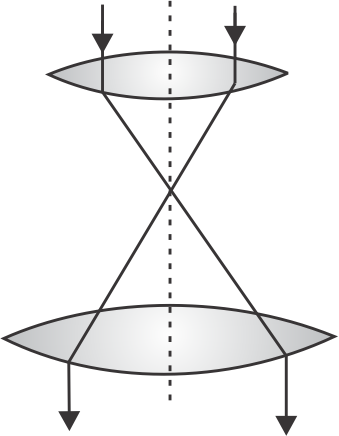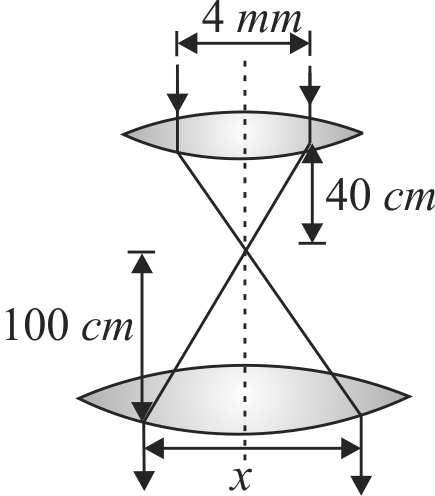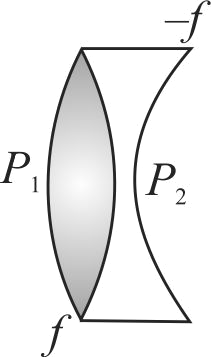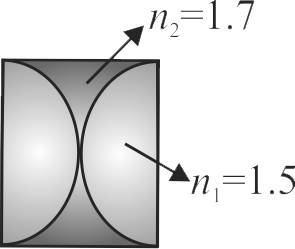364744 The size of the image of an object, which is at infinity, as formed by a convex lens of focal length \(30\;cm\) is \(2\;cm\). If a concave lens of focal length \(20\;cm\) is placed between the convex lens and the image at a distance of \(26\;cm\) from the lens, the new size of the image is
364745
Consider 'beam expander' which consists of two converging lenses of focal lengths 40 \(cm\) and 100 \(cm\) having a common optical axis. A laser beam of diameter 4 \(mm\) is incident on the 40 \(cm\) focal length lens. Then what is the diameter of the final beam (see figure) ?
364747 Two identical thin plano-convex glass lenses (refractive index 1.5) each having radius of curvature of \(20\,cm\) are placed with their convex surfaces in contact the centre. The intervening space is filled with oil of refractive index 1.7. The focal length of the combination is
364744 The size of the image of an object, which is at infinity, as formed by a convex lens of focal length \(30\;cm\) is \(2\;cm\). If a concave lens of focal length \(20\;cm\) is placed between the convex lens and the image at a distance of \(26\;cm\) from the lens, the new size of the image is
364745
Consider 'beam expander' which consists of two converging lenses of focal lengths 40 \(cm\) and 100 \(cm\) having a common optical axis. A laser beam of diameter 4 \(mm\) is incident on the 40 \(cm\) focal length lens. Then what is the diameter of the final beam (see figure) ?
364747 Two identical thin plano-convex glass lenses (refractive index 1.5) each having radius of curvature of \(20\,cm\) are placed with their convex surfaces in contact the centre. The intervening space is filled with oil of refractive index 1.7. The focal length of the combination is
364744 The size of the image of an object, which is at infinity, as formed by a convex lens of focal length \(30\;cm\) is \(2\;cm\). If a concave lens of focal length \(20\;cm\) is placed between the convex lens and the image at a distance of \(26\;cm\) from the lens, the new size of the image is
364745
Consider 'beam expander' which consists of two converging lenses of focal lengths 40 \(cm\) and 100 \(cm\) having a common optical axis. A laser beam of diameter 4 \(mm\) is incident on the 40 \(cm\) focal length lens. Then what is the diameter of the final beam (see figure) ?
364747 Two identical thin plano-convex glass lenses (refractive index 1.5) each having radius of curvature of \(20\,cm\) are placed with their convex surfaces in contact the centre. The intervening space is filled with oil of refractive index 1.7. The focal length of the combination is
364744 The size of the image of an object, which is at infinity, as formed by a convex lens of focal length \(30\;cm\) is \(2\;cm\). If a concave lens of focal length \(20\;cm\) is placed between the convex lens and the image at a distance of \(26\;cm\) from the lens, the new size of the image is
364745
Consider 'beam expander' which consists of two converging lenses of focal lengths 40 \(cm\) and 100 \(cm\) having a common optical axis. A laser beam of diameter 4 \(mm\) is incident on the 40 \(cm\) focal length lens. Then what is the diameter of the final beam (see figure) ?
364747 Two identical thin plano-convex glass lenses (refractive index 1.5) each having radius of curvature of \(20\,cm\) are placed with their convex surfaces in contact the centre. The intervening space is filled with oil of refractive index 1.7. The focal length of the combination is
364744 The size of the image of an object, which is at infinity, as formed by a convex lens of focal length \(30\;cm\) is \(2\;cm\). If a concave lens of focal length \(20\;cm\) is placed between the convex lens and the image at a distance of \(26\;cm\) from the lens, the new size of the image is
364745
Consider 'beam expander' which consists of two converging lenses of focal lengths 40 \(cm\) and 100 \(cm\) having a common optical axis. A laser beam of diameter 4 \(mm\) is incident on the 40 \(cm\) focal length lens. Then what is the diameter of the final beam (see figure) ?
364747 Two identical thin plano-convex glass lenses (refractive index 1.5) each having radius of curvature of \(20\,cm\) are placed with their convex surfaces in contact the centre. The intervening space is filled with oil of refractive index 1.7. The focal length of the combination is



